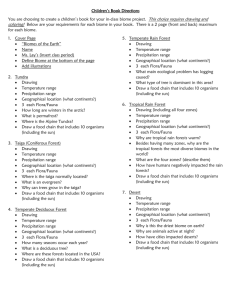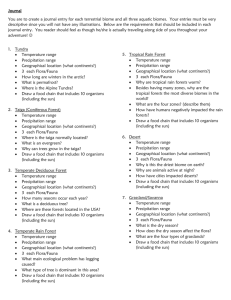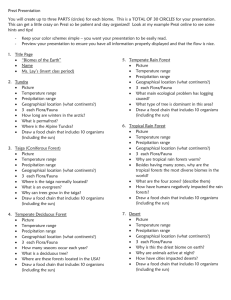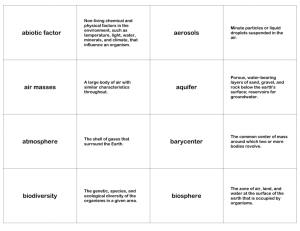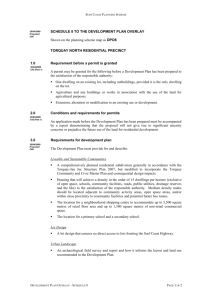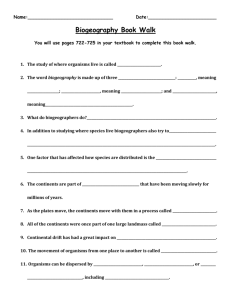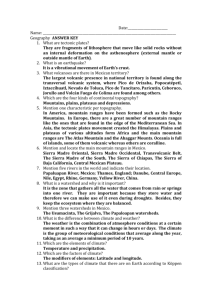Travel Brochures You must create a travel brochure for EACH
advertisement
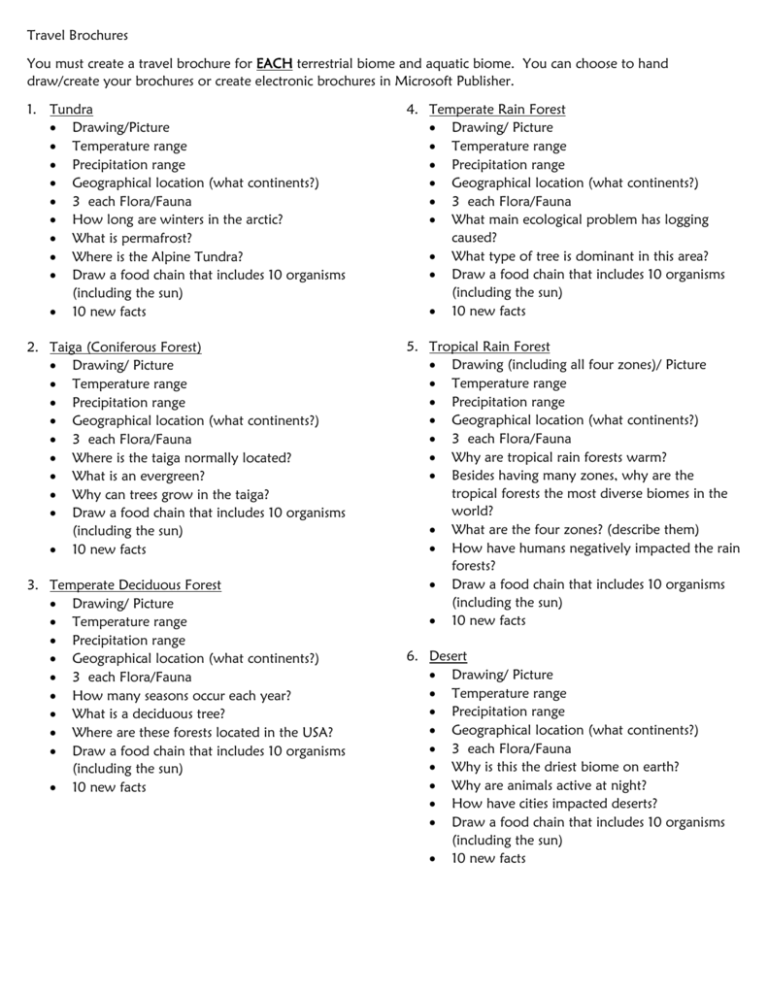
Travel Brochures You must create a travel brochure for EACH terrestrial biome and aquatic biome. You can choose to hand draw/create your brochures or create electronic brochures in Microsoft Publisher. 1. Tundra Drawing/Picture Temperature range Precipitation range Geographical location (what continents?) 3 each Flora/Fauna How long are winters in the arctic? What is permafrost? Where is the Alpine Tundra? Draw a food chain that includes 10 organisms (including the sun) 10 new facts 4. Temperate Rain Forest Drawing/ Picture Temperature range Precipitation range Geographical location (what continents?) 3 each Flora/Fauna What main ecological problem has logging caused? What type of tree is dominant in this area? Draw a food chain that includes 10 organisms (including the sun) 10 new facts 2. Taiga (Coniferous Forest) Drawing/ Picture Temperature range Precipitation range Geographical location (what continents?) 3 each Flora/Fauna Where is the taiga normally located? What is an evergreen? Why can trees grow in the taiga? Draw a food chain that includes 10 organisms (including the sun) 10 new facts 5. Tropical Rain Forest Drawing (including all four zones)/ Picture Temperature range Precipitation range Geographical location (what continents?) 3 each Flora/Fauna Why are tropical rain forests warm? Besides having many zones, why are the tropical forests the most diverse biomes in the world? What are the four zones? (describe them) How have humans negatively impacted the rain forests? Draw a food chain that includes 10 organisms (including the sun) 10 new facts 3. Temperate Deciduous Forest Drawing/ Picture Temperature range Precipitation range Geographical location (what continents?) 3 each Flora/Fauna How many seasons occur each year? What is a deciduous tree? Where are these forests located in the USA? Draw a food chain that includes 10 organisms (including the sun) 10 new facts 6. Desert Drawing/ Picture Temperature range Precipitation range Geographical location (what continents?) 3 each Flora/Fauna Why is this the driest biome on earth? Why are animals active at night? How have cities impacted deserts? Draw a food chain that includes 10 organisms (including the sun) 10 new facts 7. Grassland/Savanna Drawing/ Picture Temperature range Precipitation range Geographical location (what continents?) 3 each Flora/Fauna What is the dry season? How does the dry season affect the flora? What are the four types of grasslands? Draw a food chain that includes 10 organisms (including the sun) 10 new facts 8. Freshwater Drawing/ Picture 3 each Flora/Fauna What are the four important factors for aquatic environments? What is a wetland and where are they found? How is the vegetation in a swamp different from the vegetation in a marsh? Describe how organisms differ in a freshwater system from the surface to the bottom. Draw a food chain that includes 10 organisms (including the sun) 10 new facts 9. Salt Water Drawing (label the four zones)/ Picture 3 each Flora/Fauna How much of the water on earth is saltwater? What types of organisms are found in each level? o Intertidal zone o Neritic zone o Oceanic zone o Benthic Zone How are coral reefs formed? Draw a food chain that includes 10 organisms (including the sun) 10 new facts 10. Estuary Drawing/ Picture Temperature range Precipitation range Geographical location (what continents?) 3 each Flora/Fauna What is an estuary? Why are these areas so diverse? What makes the plant life different here? Where are estuaries found in the USA? Draw a food chain that includes 10 organisms (including the sun) 10 new facts
